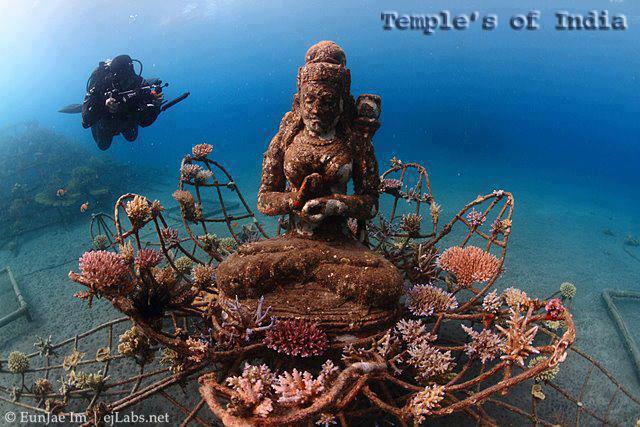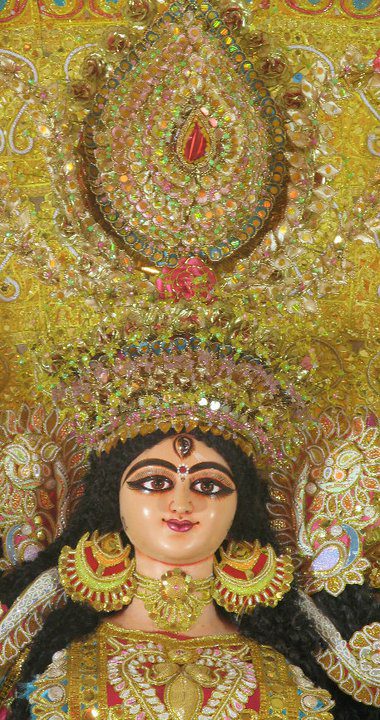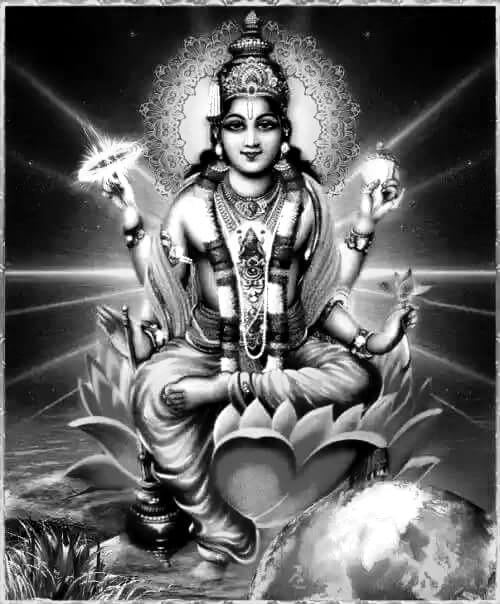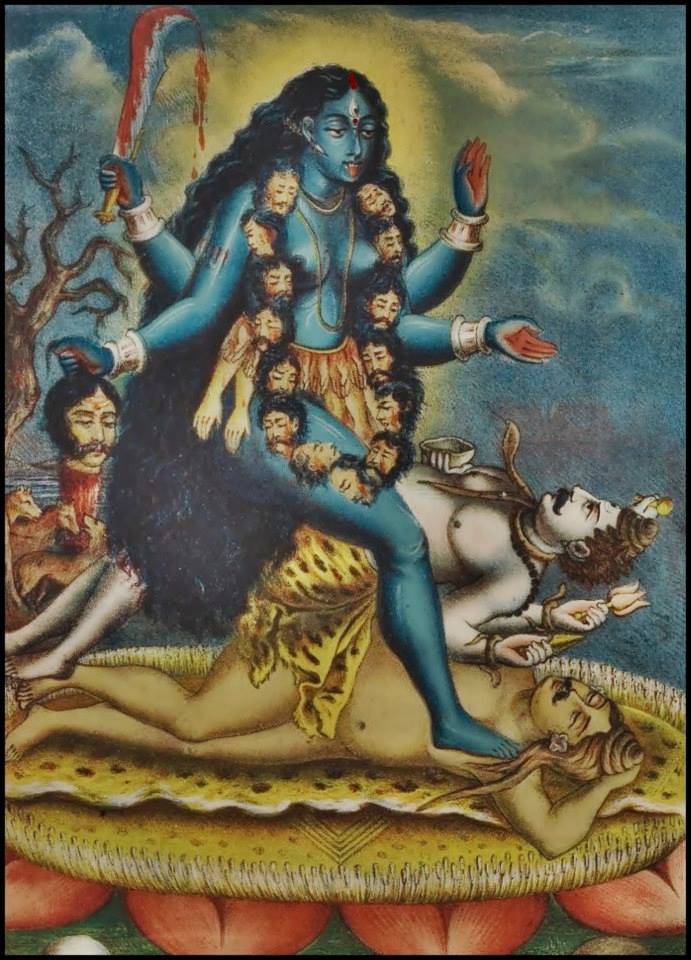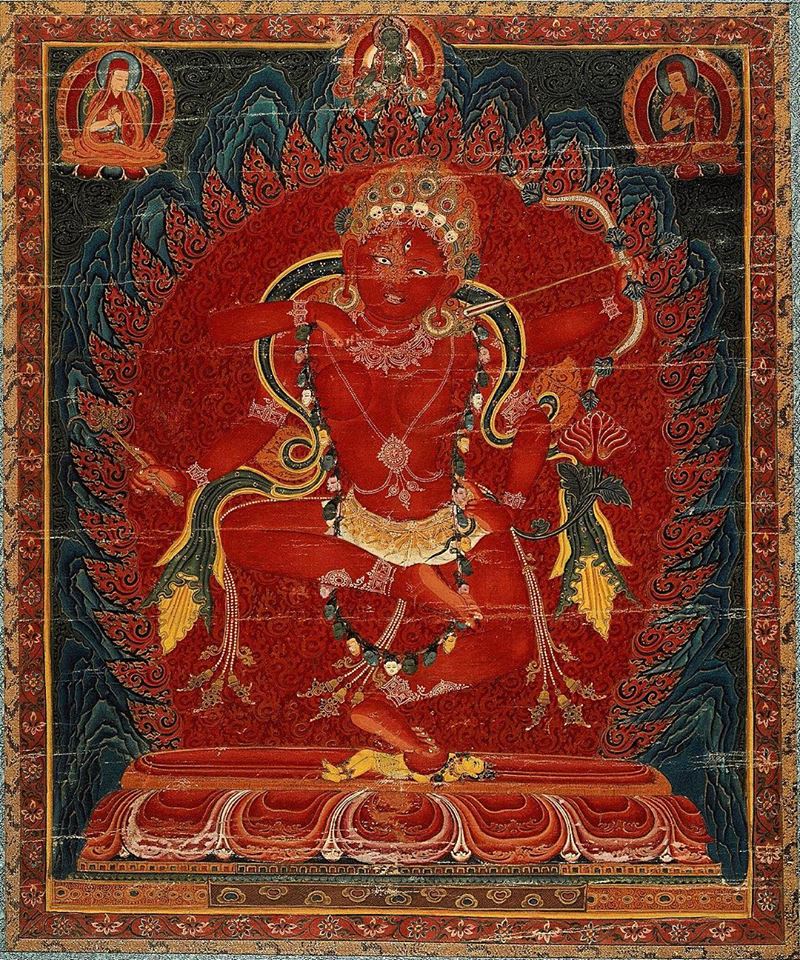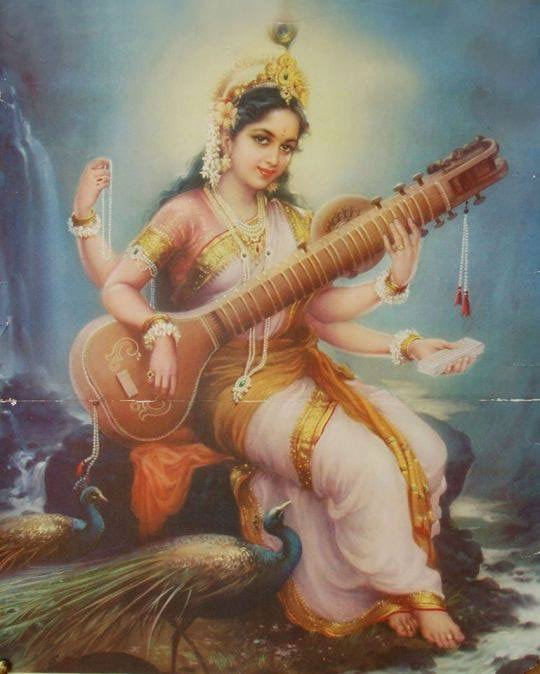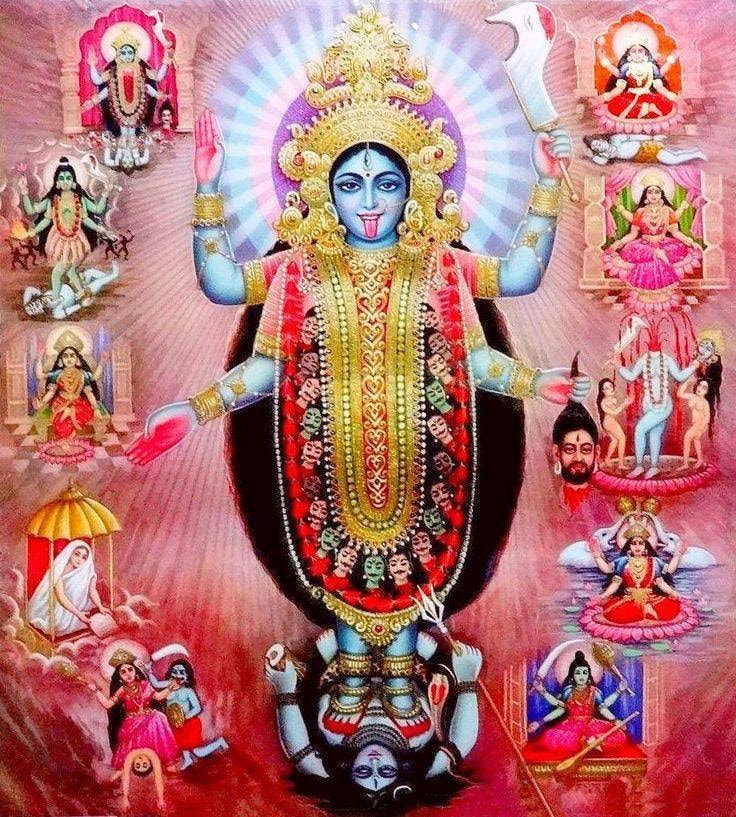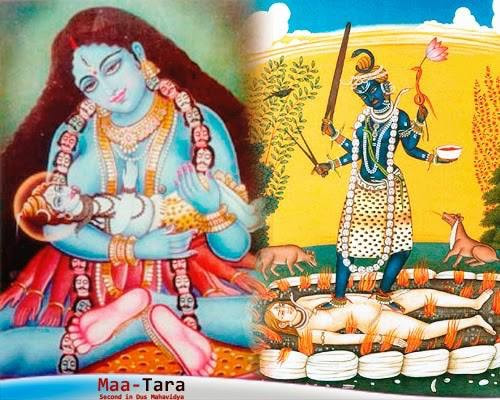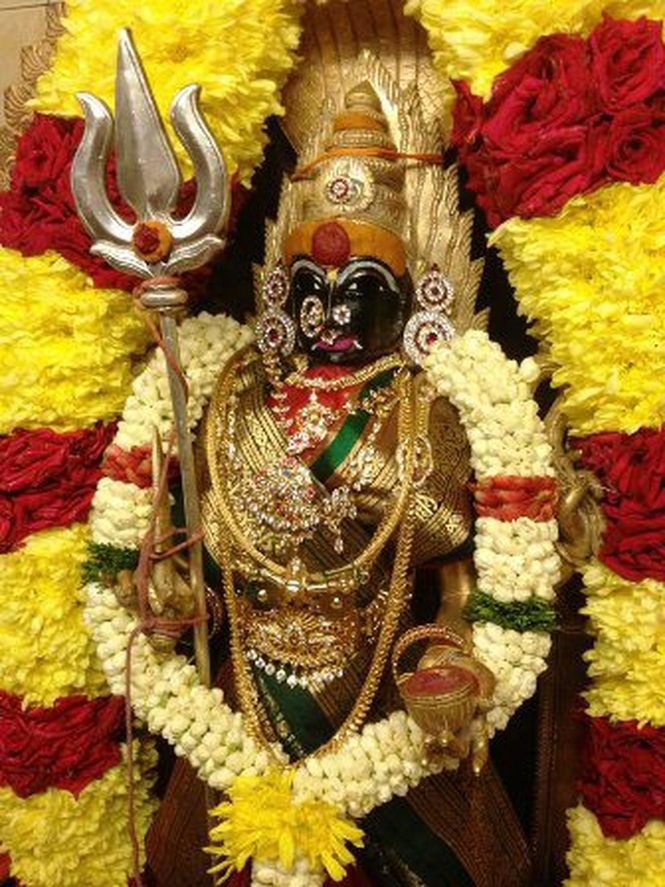
In the Daksha yagna ceremony, Parvathi’s previous incarnation, Dakshayani, immolates herself. Daksha insulted the daughter and more so, the son-in-law, Shiva. Unable to stand the insult Dakshayani brings her life to an end. That was mentioned to be Sati also. So Dakshayani nee Sati is reborn as Parvathi. As a young virgin Gowri, she does penance to win the heart of Shiva and marries him.
MAA KALI: Mother Parvathi also has an independent existence outside the company of her husband Lord Shiva and Her children Ganesha and Skanda. She is separately known as Shakti, the material energy of Siva. She is the Siva-vamanga half of Shiva as Ardhanariswara. Mother Parvathi takes a terrible form as Kali. Mother Kali manifests seven ways as Brahmi, Maheswari, Kaumari, Vaisnavi, Vahahi, Narasimhi and Aindri. These goddesses are the combined energy of Lord Brahma, Lord Shiva, Lord Vishnu, Lord Skanda and Lord Varaha. Each of the goddesses display the basic attributes of the gods from which they descended. It is also a common depiction that they carry the same weapons as the male-counterparts.
TANTRAS: The Dasamahavidyas means the ten great branches of knowledge. Here, Mother Parvati manifests as ten Tantric Goddesses to expose ten great branches of jnana. (please refer to individual postings on the Maha Vidaya Mothers) They are Mothers Kali, Tara, Sodasi, Bhuvanesvari, Bhairavi, Chinnamasta, Dhumavathi, Bagala, Matangi and Kamala. In Tantra, Mother Parvathi is often referred to as Durga. Durga is the Mother Goddess aspect of Parvathi. So one has Mother Durga spearheading the Mahavidyas. Otherwise the general consensus would be use of the term Mother Lalitha Tripurasundari, linked to the Sri Chakra.
SRI CHAKRA: Sri Chakra is a geometric pattern believed to be invested with the power of the Devi and possess the capacity to manifest desired reality if it is worshipped in a proper manner accompanied by appropriate mantras. People use these patterns known as yantras as amulets and protective devices against evil spirits and adverse conditions. Each of the Mahavidya Devis have their own Yantras.Caution is to be exercised in the use of chakras and yantras. While Yantras are powerful sources of spiritual energy, they also cause immense harm to innocent worshippers or those who misuse them. Inappropriate mantras and rituals also have negative results, if not harm to the person. In that sense yantras are twin edged blades.
PERSONIFICATIONS: Mother Parvathi is also worshiped in many other forms from being grama-devata or village deity to formalized temple goddess. At times she is venerated as a manifestation for a particular purpose. So one has, Annapurna, Aparajita, Bala, Bhadrakali, Chamunda, Gayatri, Indrakshi, Jagadhatri, Kamesvari, Katyayani, Rajarajaswari and Sivaduti. Mother Manonmani comes in this list. In more than one way, Parvathi manifestations are connected to tantric practices either through the mainframe Mahavidyas or independently. Here and there one hears the emergence of new names of Tantric goddesses, unheard of in the scriptures or Puranas. Apparently these so-called goddesses are commercialized Yantra based inventions.
CHANDRA-CRESCENT MOON: Worship of Chandra is Pan Indian but emphasized in Shaiva-Siddhanta and Shakti Pujas. Lord Shiva honored Chandra by adorning him on His head. Thus He is known as Piraichudi and Chandrasekhar. Chandra is also known as Somam of the Hilamalayas. That gave the names Someswar and Somanathar. The Kapalikas are regularly reffered to as Somasiddhantins implying that they had formulated their own set of beliefs on a rational basis of Siddhanta. It is said that Chandra has 27 wives corresponding 27 stars. He is said to have mastered all the 64 ayakalais. The crescent moon worn by Lord Shiva is the third of the sixteen faculties of Chandra.
CHANDRA THEERTHA PUJA: When Vinayaka was born, Chandra made a courtesy call to Kailasa. There he ignored Vinayaka. Chandra’s tone was different, in fact Vinayaka was laughed at despite being Lord Shiva’s son. Thus he earned a curse that he would lose his beauty of phases. Out of the 27 wives, Chandra was partial to two, so the remaining 25 also cursed together with Vinayaka. Chandra prayed to Shiva and was told visit 64 Siva temples and worship Him to regain all the 64 phases. He does so with his 2 wives. His last stop was Chandrasekharapuram to regain the 64th faculty. This pleased the Lord and placed Chandra on his head. Chandra also earned the sthala namah.
Another legend states that Chandra suffered the depletion of 16 kalas by the curse of Daksha. At Lord’s Shiva’s instance, Chandra did puja in 16 kinds of theertas with his 27 Nakshatra Devi wives. These 16 temples are known as Theertha Shakti or Chadra Shakti Temples. This worship is said to be relevant for Kali yuga for it purifies the heart, intellect, mind and thoughts. One does grivakam or circumambulation of hill temples and worships Mother Goddess Manonmani Devi. Mother Manonmani’s blessings are necessary for shanti and one-pontedness of the mind.
THEERTHAS: The Siddhas consider the following 16 types of sacred waters for ritual holy bath: Rivers, Lakes, Ponds, Ponds on hills, Springs, Sea water, Water in river beds, Water in sea shores, Water that issues out of the mouth of a Nandi, Waterfalls, Water at the junction of three rivers, Water that issues from the Gomukha in a temple , Water that issues out of the melting of snow as streams on hills and Water from rock beds on hills.
MANONMANI also has other suffixes such as Manonmaniben, Manonmanidevi or Manonmanishree. Goddess Parvathi also manifests as Mantra Shakti. So there are Goddess like Yogamoola, Thavamoola, Mantramoola and Pujamoola. Manonmanidevi is the avtar connected with mind power. This manifestation is rarely seen in Siva temples. Sri Manonmanidevi worshipped the Lord with the help of Manimantra Shakti. There is a belief Mother Sri Sulini Durga and Mother Manonmanidevi, worshiped together with Chandra during Rahukaala daily, reap enormous benefits.
LALITHA SAHASRANAMAM: In Lalitha Sahasranamam, Sri Manonmani is the secret name of Mother Durga. Lalita Sahasranama hymns Devi as Sri Mata and Sri Maharani. Her Yantra is Sri Chakra or Sri Yantra and her mantra is Sri Vidya. She is common to Kashmir and in South India for the the Sri Vidya cult. Thus in Verse 1046, Thirmular in his Thirumanthiram describes her as “ She is Sundari, the Beautiful; Andari of the form of sky; Kum-Kumi of red color; Paripurai, Maintainer of the world; Narani, Tejas or power behind Narayana; Esi, the Sakti of Isan or Siva-Mahesvara; Manonmani, Sakti of Sadasiva, the grantor of Grace. Manon+ mani = Mind + Jewel, name of Durga, Parvati.
Therefore one Sakti of Tripurasundari manifests as many; She is one and her manifestations are many. Redness is a sign of Will and Desire of Devi; her forehead mark is red; Her seat is red; the Japa Pushpa -flower is Hibiscus; garments are red; in ritual red sandal is in use.
SIDDHANTA AND TANTRA: In Pascimamnaya, Devi is the highest state of Consciousness. Pascimamnaya belongs to a category of Saivagama variously called Kulagama, Kulasastra or Kulamnaya. This part of Siddhanta is diffused as Srividya. Therefore the Pascimamnaya is an essential Tantric tradition also. Kashmiri Kaula Tantra and Trika share many features of the Pascimamnaya. Trika is an entity in ritual rather than a theology. Trika’s ‘Para’ is also identical with Tripurasundari Mother cult.
Basically in Siddhanta, Shakti is the cause of all causes. She is Rudravaktara meaning the centre where there is no time, space, tattva. So Rudravaktara is complete freedon, purity and Supremacy. This is the Shakti of Siva where there no objects and subjects. So in the Rudradhyaya Sruti; ‘Salutation to Vamadeva, supreme excellence,’ it is defined that the Shakti of Siva is named Manonmani.
MAHASADASHIVA: In this manifestation, Lord Shiva is Pure Consciousness. The Uttarakamikagama depict Siva’s Vishvaroopa darshanam as being white complexioned with Chandra, the glowing crescent moon on His locks. With five or one face, he has three eyes symbolising Agni, Chandra and Surya or Iccha Shakti, Jnana Shakti and Kriya Shakti. Now, Mahasadasiva is accompanied by His consort Goddess Manonmani. Both Mahasadashiva and Manonmani depict a state of mind. Goddess Manonmani is an emphasis of this point. Here she is the manifestation of Mother Durga. Manonmani’s has appropriate yoga mudra, for she is a state where the eyes are neither closed not open, a state where breath is neither inhaled nor exhaled, and the mind is blank, it doesn't speculate or have doubting thoughts. It is after this stage that the super consciousness is reached.
Goddess Manonmani’s state of the eyes when they are neither opened nor closed is called Nilotpala or resembling a half opened padma -lotus. Manonmani is a kind of mudra according to the Yoga-sastra, its characteristics are described thus: ‘By this process the eyes neither close nor open, by which breath is neither inhaled nor exhaled and the mind is a blank neither speculating nor doubting, direct that Manonmani towards Me.’ This state of consciousness is only reached after conquering worldly illusions and fear of death. Manonmani’s spiritual status is complemented by Siva’s Abhaya mudra, the icons of truth emphasizing that this illusionistic world is just a facade, the real truth behind which is probably too difficult to imagine and hence is represented by the Rudra form of the terrific Sadashiva and the Tryambaka; the third eye is typically associated with fierceness, but in reality the eye radiates a brilliant light, a kind of eye, the blinding brilliance which is enlightenment and opens into consciousness. Such is the brilliance of the divine couple, Mahasadasiva and Manonmani.
An interesting point arises here concerning Lord Sadasiva. He is basically a manifestation of Siva but it His consort goddess that plays a role in rituals as that is characteristic of the worship of Siva’s throne and the establishment of ‘Linga-pratishta’. At the end of the ‘asanapuja’ before God is invited to sit by the Consort’s side, She is invoked as Manomani. The point here is, if Manonmani a completely different form of the Supreme Shakti of if she is the personification of Siva’s own Shakti. There are writings in the Agamas that Manonmani is identified with the inherent Shakti of Siva and that She is Kriyasakti. There are other declarations in the Agamas that the Linga is Jnanasakti and Pitha is Kiryasakti.
PANCHALINGAS: The Panchalinga Kshetrams represent the five 5 faces of Lord Shiva. They are Pathaleshwara or Vasukhishwara; Maruleshwara or Saikateshwara; Arkeshwara, Vaidyanatheeshwara and Mallikarjuna. These kshetras are dedicated to Lord Shiva worship. In Mallikarjuna temple, the Lord is Mallikarjuna Swamy and the Goddess is Brahmaraambigai. In Vaidyanatheeshwara Temple, the lord is Vaidyanatheeswara and the Goddess is Manonmani.
VAIDYANATHA TEMPLE: This is a Panchalinga kshetra in Talakadu, Karnataka. The presiding Deities in this temple are Lord Vaidyanatheeshwara and Goddess Manonmani. There are two huge beautifully structured and ornamented dwarapalakas at the entrance of the Vaidyanatha temple, a Ganesha idol on his munjur vahanam on the right. It is said that the royal family entered the temple for worship through an entrance to the south of the front mandapam. In the inner mandapam, there are idols of Lord Nataraja, Durgai, Badhrakaali, Kaaligambal, Shaaradaambigai. On either side of the main sanctum are the idols of Lord Ganesha and Muruga.
NAYANMAARS: Narasinga Muniyaraiyar Nayanar was as ardent devotee of Goddess Manonmani and Lord Siva. He was born in Thirunavalur and was the chieftain of Thiru Munaipadi. In the local temple, Narasinga worshipped Lord Thirunavaleswarar with his consort Goddess Manonmani in the temple located here. He treated devotees of Lord with utmost reverence. and provided them with all the necessities. As any other day, Narasinga Muniyaraiyar conducted a ritual on the auspicious day of Thiruvathira, the place was over crowded with the devotees of Lord.
On one such occassion, there appeared a devotee dressed dreadfully; smeared ash marks all over his bare body and the matted hair locks were adorned by Rudraksha. The devotees gathered were stared at him in an aversion. Narasinga leaped himself into the crowd, he envisioned Lord in his guest who was dressed awfully and prostrated before him. The crowds gathered were witnessed the modesty of Narasinga Muniyar. It was an illustration of the subtle way in which Nayanmaars manifest their cosmic vision and also the subtle way in which to bring about the necessary change in the outlook of others.
SRI GOURI ASTHOTHARA SATHANAMAVALLI: This stotra stars with the mantra “Om Maha Manonmani Shakthyai Nama” and ends with Parath Parayai Nama: Jai Ambey Ma. (It is too long to post here)
Hara Hara Mahadeva
(draft Gods, Goddesses, Minor Deities and Sages)
by Yogi Ananda Saraswathi



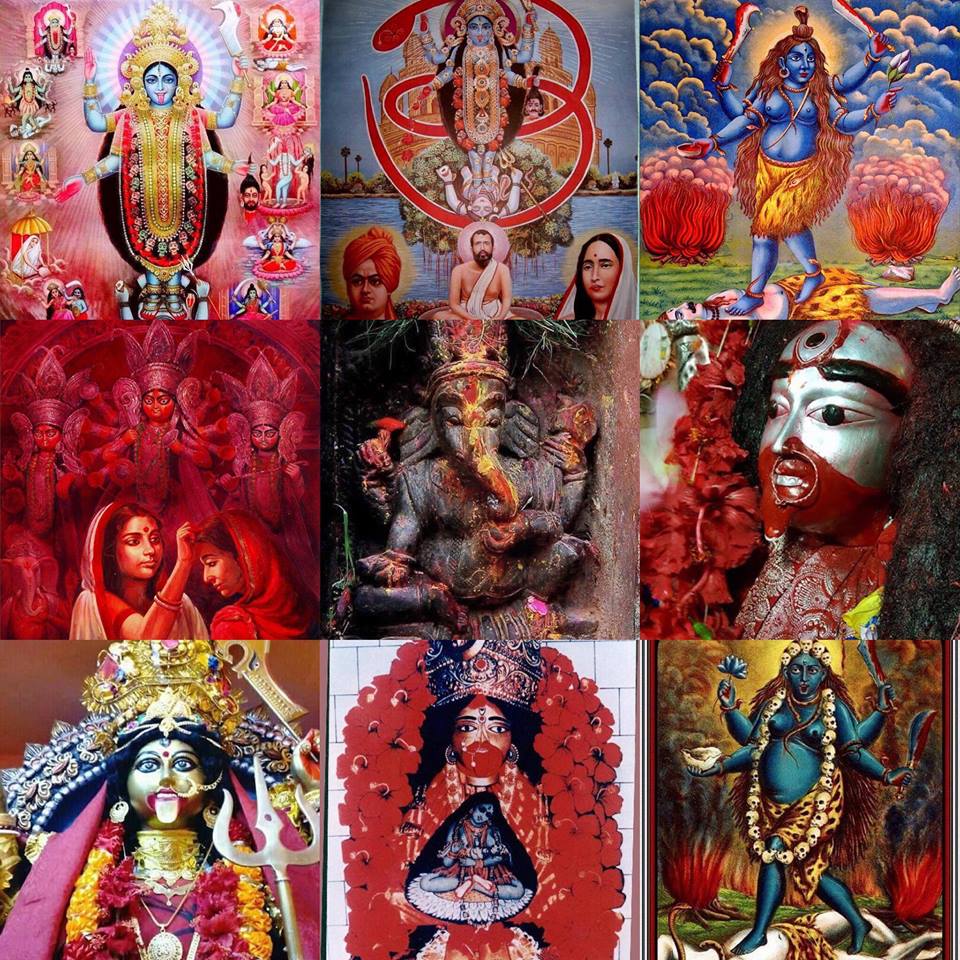
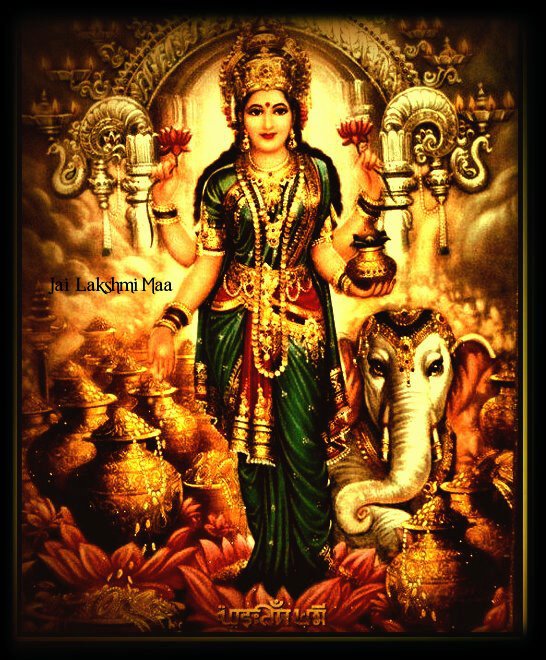

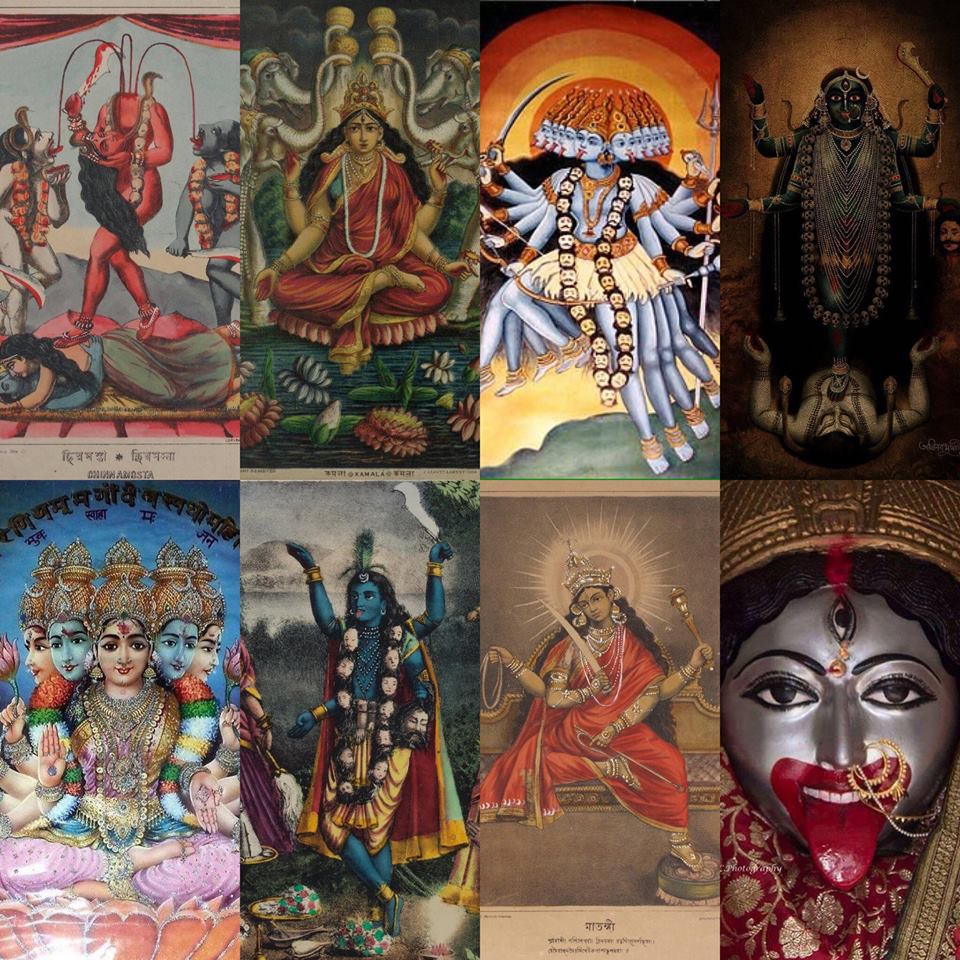
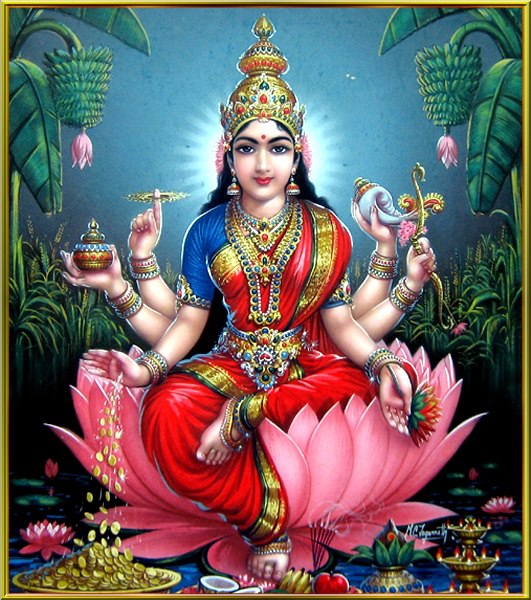



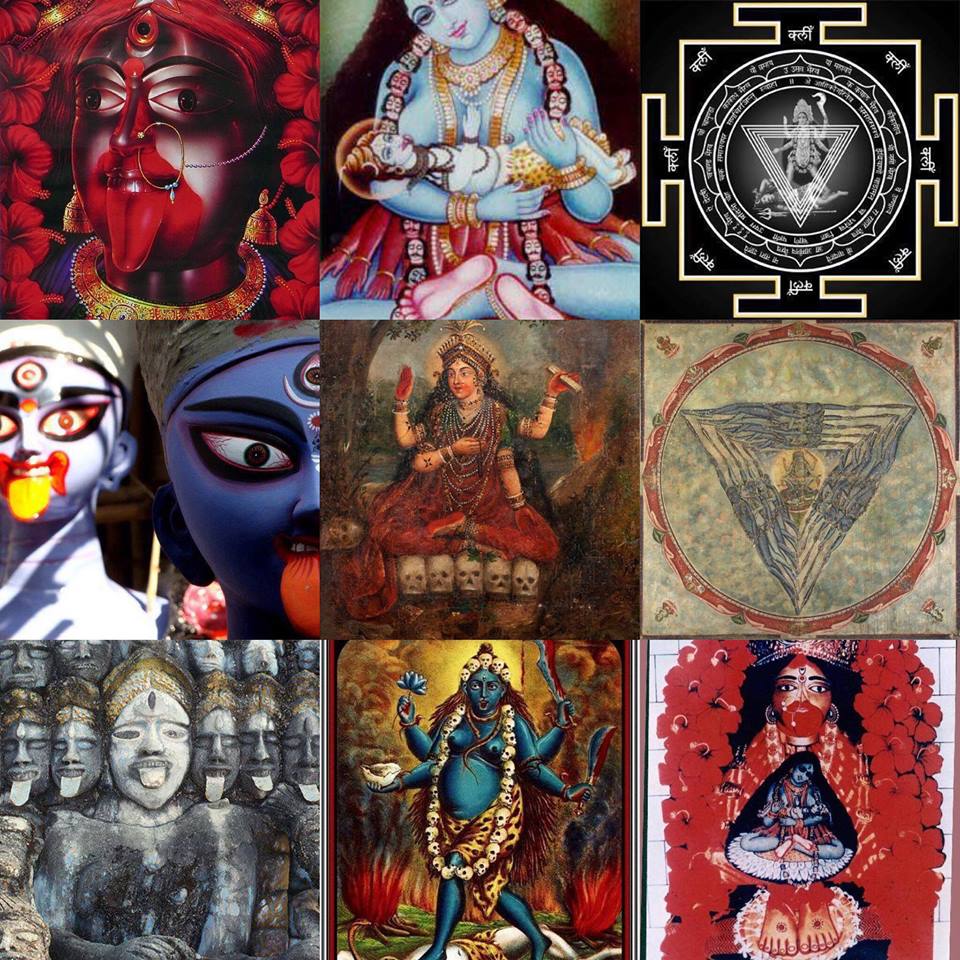


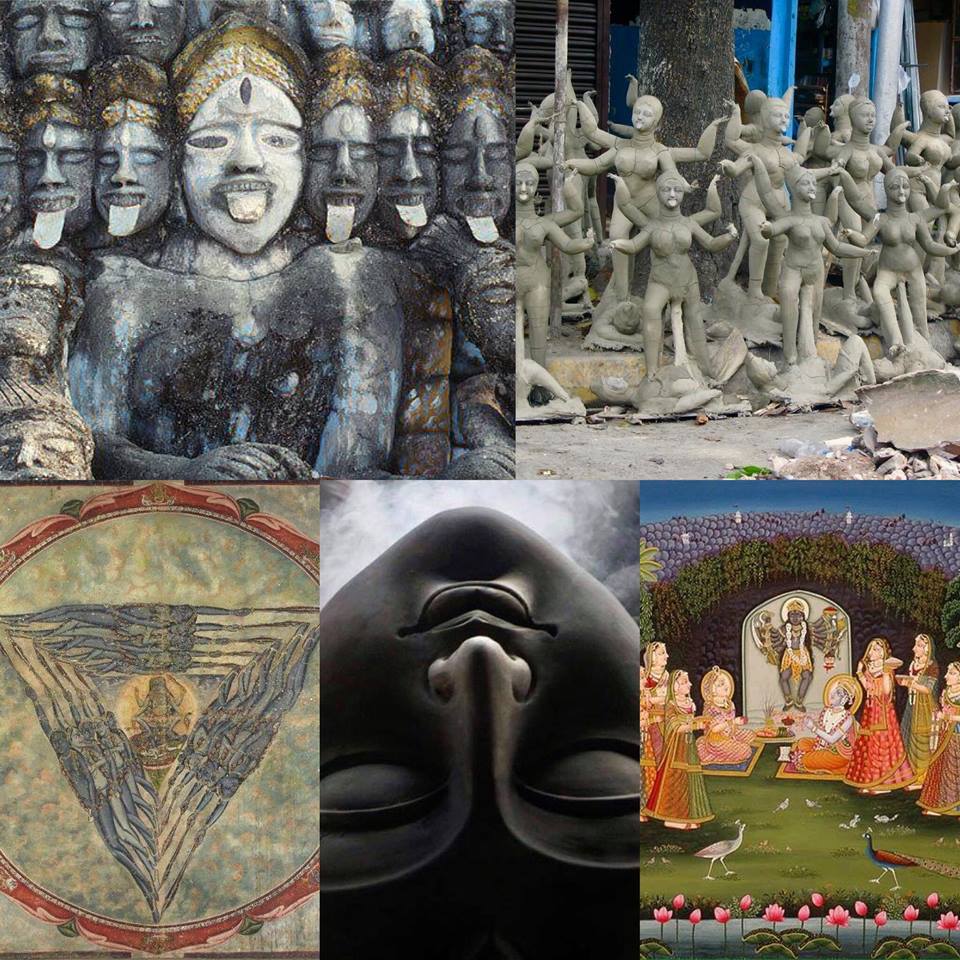







 RSS Feed
RSS Feed























